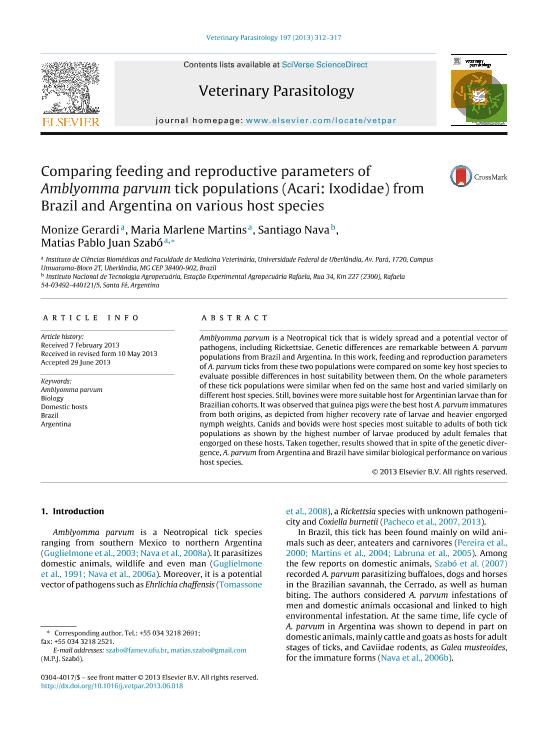Artículo
Comparing feeding and reproductive parameters of Amblyomma parvum tick populations (Acari: Ixodidae) from Brazil and Argentina on various host species
Fecha de publicación:
09/2013
Editorial:
Elsevier
Revista:
Veterinary Parasitology
ISSN:
0304-4017
Idioma:
Inglés
Tipo de recurso:
Artículo publicado
Clasificación temática:
Resumen
Amblyomma parvum is a Neotropical tick that is widely spread and a potential vector of pathogens, including Rickettsiae. Genetic differences are remarkable between A. parvum populations from Brazil and Argentina. In this work, feeding and reproduction parameters of A. parvum ticks from these two populations were compared on some key host species to evaluate possible differences in host suitability between them. On the whole parameters of these tick populations were similar when fed on the same host and varied similarly on different host species. Still, bovines were more suitable host for Argentinian larvae than for Brazilian cohorts. It was observed that guinea pigs were the best host A. parvum immatures from both origins, as depicted from higher recovery rate of larvae and heavier engorged nymph weights. Canids and bovids were host species most suitable to adults of both tick populations as shown by the highest number of larvae produced by adult females that engorged on these hosts. Taken together, results showed that in spite of the genetic divergence, A. parvum from Argentina and Brazil have similar biological performance on various host species.
Palabras clave:
Amblyomma
,
Biology
,
Domestic Host
,
Brazil
,
Argentina
Archivos asociados
Licencia
Identificadores
Colecciones
Articulos(CCT - SANTA FE)
Articulos de CTRO.CIENTIFICO TECNOL.CONICET - SANTA FE
Articulos de CTRO.CIENTIFICO TECNOL.CONICET - SANTA FE
Citación
Gerardi, Monize; Martins, Maria Marlene; Nava, Santiago; Juan Szabó, Matias Pablo; Comparing feeding and reproductive parameters of Amblyomma parvum tick populations (Acari: Ixodidae) from Brazil and Argentina on various host species; Elsevier; Veterinary Parasitology; 197; 1-2; 9-2013; 312-317
Compartir
Altmétricas




